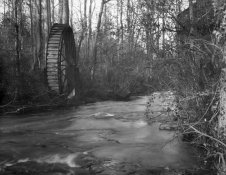Effectivepixels
Member
- Joined
- Feb 3, 2015
- Messages
- 11
- Format
- 4x5 Format
I'm relatively new to paper negatives in general and have been slowly getting into it due to its ease of developing and economy compared to large format film. One thing I have yet to work out is what the general dynamic range is for paper. I know its probably situational but just trying to figure a rule of thumb and if there is anything that can be done to reign in the highlights which seem to be the biggest problem with paper. I'm using an uncoated lens and grade 2 paper in an effort to bring down contrast a bit. My next step is to start preflashing but for now my best results come from subdued scenes and anything with wide latitude of exposure doesn't come out appealing to me.
For example two shots from this weekend. The first was in a shaded subdued area but the second has some sky which I can't get to retain any detail. Is this a limitation of the format or is it something I can overcome with the right technique.


For example two shots from this weekend. The first was in a shaded subdued area but the second has some sky which I can't get to retain any detail. Is this a limitation of the format or is it something I can overcome with the right technique.







